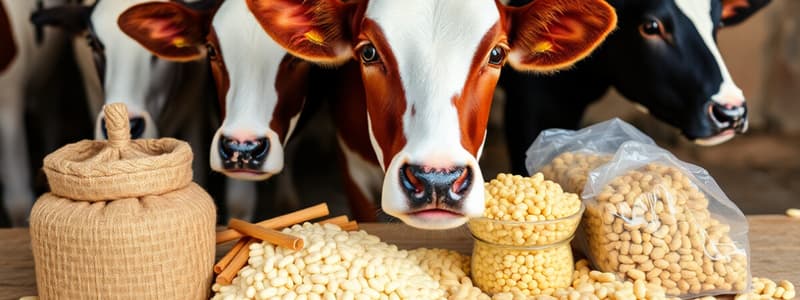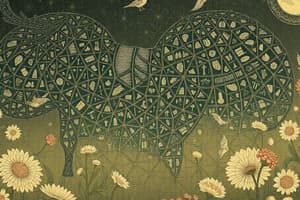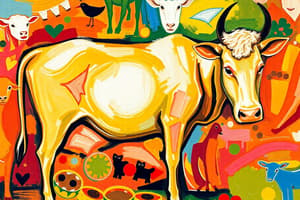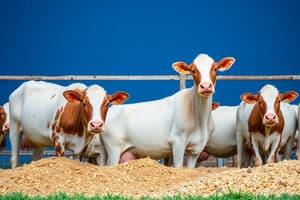Podcast
Questions and Answers
What is a key characteristic that defines a nutrient in animal nutrition?
What is a key characteristic that defines a nutrient in animal nutrition?
- It is only necessary for production purposes in animals.
- It is a chemical substance found in feed material. (correct)
- It excludes carbohydrates, proteins, lipids, minerals, and vitamins.
- It is solely derived from synthetic sources.
Which statement accurately describes 'feed' with respect to animal nutrition?
Which statement accurately describes 'feed' with respect to animal nutrition?
- A supplement used to enhance the color of animal products.
- A synthetic compound designed to accelerate growth.
- A processed substance used to treat diseases in animals.
- Any naturally occurring ingredient or mixture of ingredients, fed to animals for the purpose of nourishing them. (correct)
How is 'ration' defined in the context of animal nutrition?
How is 'ration' defined in the context of animal nutrition?
- The process of diluting feed with water for easier consumption.
- The amount of feed an animal receives in a 24-hour period. (correct)
- The total nutritional requirements of an animal over its lifetime.
- The proportion of protein to carbohydrates in an animal's diet.
What distinguishes 'feedstuff' from other components in animal nutrition?
What distinguishes 'feedstuff' from other components in animal nutrition?
What does 'as-fed' refer to in animal nutrition?
What does 'as-fed' refer to in animal nutrition?
How is 'dry matter' defined in animal nutrition?
How is 'dry matter' defined in animal nutrition?
What does Total Digestible Nutrients (TDN) measure in animal feed?
What does Total Digestible Nutrients (TDN) measure in animal feed?
What aspect of animal feeding does the Feed Conversion Ratio (FCR) assess?
What aspect of animal feeding does the Feed Conversion Ratio (FCR) assess?
How does Feed Conversion Efficiency (FCE) relate to animal feeding?
How does Feed Conversion Efficiency (FCE) relate to animal feeding?
What does 'digestibility' refer to in the context of animal nutrition?
What does 'digestibility' refer to in the context of animal nutrition?
What does Gross Energy (GE) represent in animal nutrition?
What does Gross Energy (GE) represent in animal nutrition?
How is Digestible Energy (DE) determined in animal nutrition?
How is Digestible Energy (DE) determined in animal nutrition?
What is the definition of Metabolizable Energy (ME) in animal nutrition?
What is the definition of Metabolizable Energy (ME) in animal nutrition?
Net Energy (NE) is the amount of energy actually available for which functions?
Net Energy (NE) is the amount of energy actually available for which functions?
According to the classification of feedstuff, what primarily defines dry roughages?
According to the classification of feedstuff, what primarily defines dry roughages?
What is a key characteristic of dry roughages?
What is a key characteristic of dry roughages?
Under what condition is a feed classified as a roughage?
Under what condition is a feed classified as a roughage?
Which of the following is an example of a dry roughage?
Which of the following is an example of a dry roughage?
What primary characteristic defines succulent roughages?
What primary characteristic defines succulent roughages?
Which of the following is classified as a succulent roughage?
Which of the following is classified as a succulent roughage?
What distinguishes silages and haylages from other types of feed?
What distinguishes silages and haylages from other types of feed?
What is the dry matter (DM) content range typically found in silage?
What is the dry matter (DM) content range typically found in silage?
What is the typical dry matter (DM) content range of haylage?
What is the typical dry matter (DM) content range of haylage?
Which category of feedstuff includes cereal grains and molasses?
Which category of feedstuff includes cereal grains and molasses?
What is a key characteristic of protein concentrates?
What is a key characteristic of protein concentrates?
Which of the following is an example of a protein concentrate?
Which of the following is an example of a protein concentrate?
Which statement is true regarding vitamins and mineral supplements in animal nutrition?
Which statement is true regarding vitamins and mineral supplements in animal nutrition?
What is the primary function of feed additives in animal nutrition?
What is the primary function of feed additives in animal nutrition?
Which of the following is considered a feed additive?
Which of the following is considered a feed additive?
Based on the provided composition data, which animal has the highest percentage of water in its body on an 'as such' basis?
Based on the provided composition data, which animal has the highest percentage of water in its body on an 'as such' basis?
Flashcards
Nutrient(s)
Nutrient(s)
Chemical substances found in feed material, necessary for growth, maintenance, production, and health of animals; includes carbohydrates, proteins, lipids, minerals, and vitamins.
Feed
Feed
Any naturally occurring ingredient or mixture of ingredients, fed to animals for nourishing them.
Ration
Ration
The amount of feed an animal receives in a 24-hour period.
Feedstuff
Feedstuff
Signup and view all the flashcards
As-fed
As-fed
Signup and view all the flashcards
Dry Matter
Dry Matter
Signup and view all the flashcards
Total Digestible Nutrients (TDN)
Total Digestible Nutrients (TDN)
Signup and view all the flashcards
Feed Conversion Ratio (FCR)
Feed Conversion Ratio (FCR)
Signup and view all the flashcards
Feed Conversion Efficiency (FCE)
Feed Conversion Efficiency (FCE)
Signup and view all the flashcards
Digestibility
Digestibility
Signup and view all the flashcards
Gross Energy (GE)
Gross Energy (GE)
Signup and view all the flashcards
Digestible Energy (DE)
Digestible Energy (DE)
Signup and view all the flashcards
Metabolizable Energy (ME)
Metabolizable Energy (ME)
Signup and view all the flashcards
Net Energy (NE)
Net Energy (NE)
Signup and view all the flashcards
Dry Roughages
Dry Roughages
Signup and view all the flashcards
Succulent Roughages
Succulent Roughages
Signup and view all the flashcards
Silages & Haylages
Silages & Haylages
Signup and view all the flashcards
High Energy Concentrates
High Energy Concentrates
Signup and view all the flashcards
Protein Concentrates/Supplements
Protein Concentrates/Supplements
Signup and view all the flashcards
Vitamins & Mineral Supplements
Vitamins & Mineral Supplements
Signup and view all the flashcards
Feed Additives
Feed Additives
Signup and view all the flashcards
Study Notes
Basic Terms in Animal Nutrition
- Nutrients are chemical substances in feed needed for growth, maintenance, production, and health, including carbohydrates, proteins, lipids, minerals, and vitamins.
- Feed can be any naturally occurring ingredient or combinations given to animals for nourishment.
- A Ration is the amount of feed an animal gets over 24 hours.
- Feedstuff refers to any ingredient in a diet (ration) that serves a useful purpose.
- As-fed refers to feed as it is normally provided to animals, moisture included.
- Dry matter is the total weight of feed, not including the water.
- Total Digestible Nutrients (TDN) measures the energy value available in a feedstuff.
- Feed Conversion Ratio (FCR) measures the rate at which an animal converts feed into meat.
- Feed Conversion Efficiency (FCE) measures an animal's ability to convert feed into flesh.
- Digestibility is quantifying the digestion process.
- Digestibility is the extent that ingested food and its nutrient components are digested and absorbed.
- Digestibility is measured by feed intake minus faeces output.
- Gross Energy (GE) is the total energy within a feed.
- Gross Energy is accounted for before any losses from digestive, metabolic, or productive functions.
- Digestible Energy (DE) is the energy available for use by an animal.
- Digestible Energy is estimated by subtracting energy loss in faeces from gross energy intake.
- Metabolizable Energy (ME) is the gross feed energy minus the energy lost in faeces, urine, and gaseous products.
- Net Energy (NE) is the amount of energy in feed that is available for maintenance, growth, and production.
- Net Energy is the proportion of ME remaining after energy expended in body heat, NE = ME – heat increment of feeding.
Classes of Feedstuff
- Dry roughages: bulky feeds with low weight per unit volume and high crude fiber content.
- Dry roughages have generally low protein and fat digestibility.
- Dry roughages are classified as roughage if it has over 18% crude fiber and 70% total digestible nutrients.
- Dry roughage examples include hay, straw & chaff, sugarcane bagasse, corn cobs, and cottonseed hulls.
- Succulent roughages include pasture grasses natural and cultivated, legumes fresh, tree leaves, roots, and tubers.
- Silages and haylages are fermented high-moisture feeds made from plant material.
- Silage contains 20% to 45% DM, while haylage contains 50% to 75% DM.
- High-energy concentrates include cereal grains, milling by-products of cereal grains, molasses, and animal & vegetable fat.
- Protein concentrates/supplements contain more than 20% Crude Protein (CP).
- Protein supplements include oil seeds and their meals, animal/avian/marine sources, milk and by-products, brewery/distillery by-products, urea, and ammonia.
- Vitamins & Mineral Supplements, animals must be able to absorb.
- Vitamin concentrations in plant and animal tissues varies.
- Plant vitamin concentrations are affected by harvesting, processing, and storing.
- Animal livers and kidneys are good sources of vitamins.
- Feed Additives are non-nutritive ingredients that stimulate growth or improve the efficiency of feed.
- Feed additives are added in very small quantities.
- Feed additives include antibiotics, antifungals, antimicrobials, probiotics, buffers, colors, flavors, hormones, and enzymes.
Studying That Suits You
Use AI to generate personalized quizzes and flashcards to suit your learning preferences.




